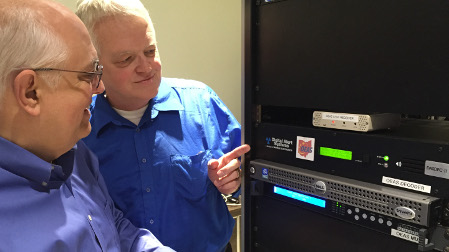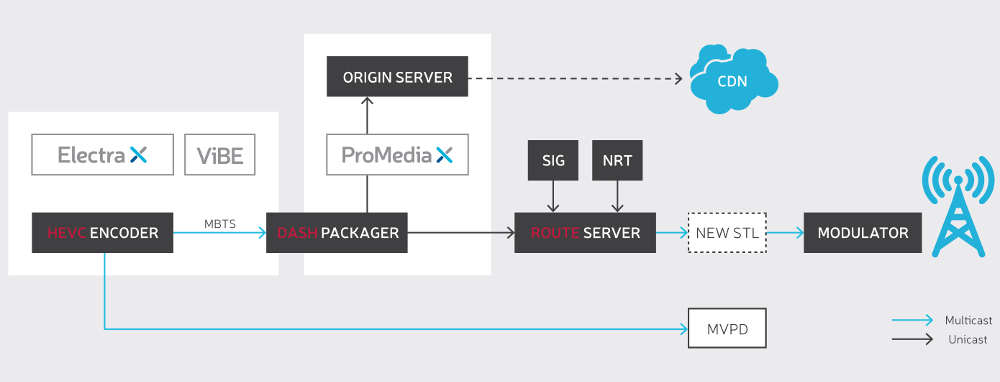Ohio Public Stations Datacast EAS Messages Over ATSC 1.0
COLUMBUS, OHIO—Ohio Education Television Stations (OETS) is using the datacasting capacity of its ATSC 1.0 HDTV broadcasts to deliver emergency communications in Ohio during manmade and natural disasters. Meant to provide a redundant alternative to vulnerable internet-based communications during emergencies, the “OEAS (Ohio Digital Emergency Alerting System) Public AlertNet” uses a 128 kbps data allocation within the 12 OETS’ PBS stations’ HDTV broadcasts to transmit critical alerts and messages to other broadcasters for delivery to the public, with the future option of also serving police, fire and ambulance services with encrypted messaging.

Dave Carwile (L), OEAS Project Manager for OETS and WOSU Public Media and Tim Kelly, WOSU-TV Chief Engineer check out the receiver operation.
The OEAS Public AlertNet system was used on-air for the first time on Dec. 14, 2016, to deliver common alerting protocol (CAP) messages in English and Spanish during the state’s monthly EAS communications test exercise. The over-the-air transmission replaced the legacy EAS links that connect Ohio broadcasters to the state’s emergency management agency.
“The test went perfectly,” said OEAS Project Manager Dave Carwile of OETS and WOSU Public Media. “We proved that datacasting can be used to pass on local CAP, FEMA IPAWS (Integrated Public Alert & Warning System), and, in the future, NWS (National Weather Service) messages to other broadcasters and government agencies; all without needing the ‘last mile internet’ to carry the traffic. Given the issues with ‘last mile’ delivery during Hurricane Sandy and other major disasters, being able to deliver redundant communications via our secure television system is an extremely important alternative.”
THE NITTY GRITTY
OETS developed the OEAS Public AlertNet in partnership with the Ohio Emergency Management Agency (OhioEMA) and Ohio’s Broadcast Educational Media Committee (BEMC) with funding from the Corp. for Public Broadcasting.
The system is built on Monroe Electronics’ Digital Alert Systems platform and includes Monroe’s Emergency Operations Center (DASEOC) to originate, translate or relay CAP alerts, with a DASDEC-II unit serving as message aggregator. The content moves on to a Triveni Digital Skyscraper hub, then over secure fiber to the 12 digital transmitters operated by the eight OEAS member operations.
Get the TV Tech Newsletter
The professional video industry's #1 source for news, trends and product and tech information. Sign up below.
At the user end, an ATSC receiver delivers the signal to DASDEC LC (DASLC) emergency content servers, outfitted with IPAWS emulation software that makes the content available to legacy EAS machines.
Here’s how the OEAS Public AlertNet system works.
The process starts at the OhioEMA’s emergency operations center in Columbus, Ohio. This is where Ohio-related CAP and IPAWS messages are created or received for relay.
“All of these public warning messages are fed into the DASEOC, which authenticates and transfers them to the Aggregator for assembly into a single data stream,” said Ed Czarnecki, senior director of strategy and government affairs for Monroe Electronics. “The DASEOC unit can also process federal, statewide and county messages that need to be received by state first responders. All of these messages are assembled in a sequential manner, to simplify transmission and reception.”
Once this data stream has been encapsulated into a unique DTV transport stream by Triveni Digital’s SkyScraper data broadcasting equipment at the OhioEMA, the stream is delivered to the OETS master control rooms by BEMC over the state’s secure fiber optic network.
SkyScraper is a digital content distribution system that lets broadcasters decide how much bandwidth to allocate for data streams within their transmissions; insert those data streams into those signals; and include targeting information that ensures the data is only decoded by specific “addressable” receivers if desired. (This targeting is done back at the OhioEMA headquarters, using SkyScraper’s DataFab feature.)
When the data stream is received at each public broadcast location, it is multiplexed into the station’s digital broadcast signal. Ohio’s public stations provide virtually 100-percent coverage to all broadcast and cable facilities in Ohio, plus county public safety agencies.
A diagram of the ATSC 3.0 unified architecture. Since the current ATSC 1.0-based system can deliver any IP-based signal, it will be available for upgrade when ATSC 3.0 systems come online.

Click on the Image to Enlarge
At this point, the OEAS Public AlertNet messages go out over the air as a data stream in OETS’ HDTV transmissions. In this initial phase of the program, messages are going to receivers provided to all of Ohio’s legacy EAS LP radio stations and selected county EMA offices. However, they can be received by other TV and radio stations, first responder agencies and any other involved departments using digital TV data receivers that are integrated with Monroe Electronic’s DASLC emergency content management servers with IPAWS Emulation modules. Notably, beyond the IPAWS emulators provided by Monroe, all other DASDEC devices running v3.0 software can simply have a feature enabled to allow them to integrate with the OEAS system as well.
The DASLC translates the data stream, so that it can be polled by the reception site’s existing EAS equipment in the message’s native format. All 12 PTV stations transmit the same signal and the legacy EAS equipment continues to parse the content appropriate to their locations.
The result: “The emergency messages get through to everyone who need them; all without relying on the last mile internet,” said Czarnecki. “As new information comes into OhioEMA, the message assembly, encoding and distribution process repeats itself. This means that there is a constantly updated stream of emergency messages travelling from OhioEMA to the OEAS stations via HDTV broadcasts to everyone who needs this vital information in real time.”
APPLICABLE TO OTHER STATES
Ohio’s success in harnessing ATSC HDTV broadcasts to emergency messaging is a model that can be applied by broadcasters in other jurisdictions.
“There is no reason why broadcasters in other states, no matter how big or small, cannot do what we did and provide a redundant EAS communications system or encrypted messaging to first responders,” said Carwile. “ATSC’s datacasting capability is ideally suited for getting CAP, IPAWS, and other digital messaging to everyone who needs them without having to unilaterally rely on the last mile internet.”
Not surprisingly, OEAS is seeing a lot of interest in the OEAS Public AlertNet system from other states.
“In addition to talking to the emergency messaging people, we’ve had representatives of some of the commercial television groups in the state asking if they could purchase receiver packages so they could monitor the system directly and we will be making those available this year,” Dave Carwile said. He expects that “as we add more of the features we’re working toward—specifically weather, video and rich media for Amber Alerts—there will be more of a demand from the TV folks. The architecture is now in place, and since it can deliver any IP-based signal, it will be available for upgrade when ATSC 3.0 systems come online.”
For more information about the OEAS Public AlertNet system, contact Dave Carwile at carwile.1@osu.edu or call 614-292-9567.
James Careless is an award-winning journalist who has written for TV Technology since the 1990s. He has covered HDTV from the days of the six competing HDTV formats that led to the 1993 Grand Alliance, and onwards through ATSC 3.0 and OTT. He also writes for Radio World, along with other publications in aerospace, defense, public safety, streaming media, plus the amusement park industry for something different.

